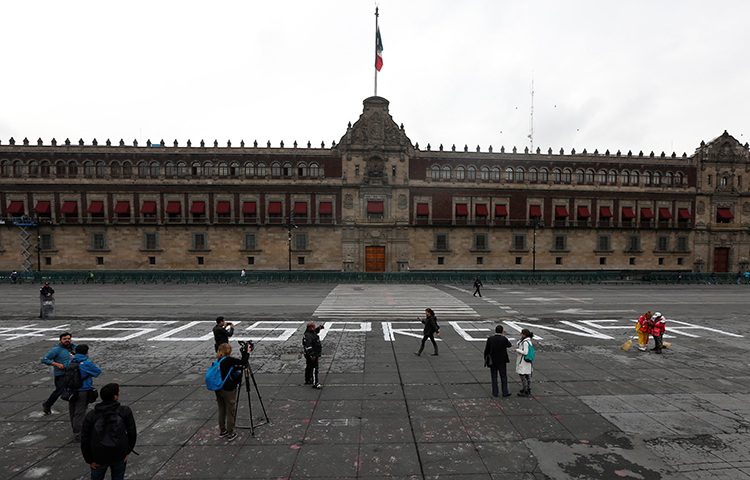Mexico City, January 10, 2018–Authorities in Mexico’s Guerrero state should thoroughly and credibly investigate alleged police violence against a reporter in the town of La Concepción on January 7, the Committee to Protect Journalists said today. According to statements five reporters gave to local media after the alleged violence, state policemen attacked a journalist covering violent clashes between police and soldiers and members of a self-styled community police force.
Photographer Bernandino Hernández, who contributes to The Associated Press and the Mexican photo agency Cuartoscuro, told CPJ on January 8 that state police beat him up after he took photos of government officers beating several members of the community police force including some who were unarmed.
The photographer said that, though he identified himself as a journalist, the policemen shouted that they didn’t care who he works for and that they “would make him disappear” if he continued to take pictures.
“It is the job of the police to protect journalists, but we’ve seen too many cases in Mexico where police are the culprits in violence against journalists,” said Alexandra Ellerbeck, CPJ’s North America Program Coordinator, from New York. “Authorities should investigate this attack and prosecute any officers responsible.”
Roberto Álvarez Heredia, a spokesperson for the Guerrero Coordination Group, which oversees all local and federal law enforcement in the state, told CPJ today that state authorities are investigating the attack.
“The government of Guerrero regrets what happened and it is our commitment to properly investigate the matter to prevent it from happening again,” Álvarez Heredia said, adding that he was as of yet unable to provide further details about the police officers allegedly involved.
CPJ was unable to reach the National Defense Secretariat in Mexico City or the Community Police in La Concepción for comment.
Reporters were documenting ongoing attempts from government authorities to disarm the community’s self-styled police force and arrest an outspoken local community leader, according to the journalists with whom CPJ spoke and news reports. The community police refused to hand over their weapons, prompting a shootout at approximately 11:30 a.m. on January 7, according to news reports. At least three community police died in the crossfire, the reports said.
During the course of the shootout, state police began attacking journalists, three reporters who were present at the scene told CPJ.
Hernández told CPJ that he was hospitalized after police beat him with their hands and kicked him. The photojournalist said that policemen damaged his cameras, took his memory cards containing photos of alleged acts of abuse they committed during the protests, and stole his money.
Hernández said he lost consciousness for several minutes during the attack. The photojournalist’s colleagues dragged him away from the scene and evacuated him by car to the Guerrero state capital of Chilpancingo, where he reported the attack to the state authorities. He was then brought to a hospital in Acapulco to be treated for his injuries, he said.
He told CPJ that he suffered a concussion and bruises on his legs, torso and head, but no brain damage. On January 9, while conversing with CPJ, he had trouble fully recollecting all details of the incident.
The state health secretary, Carlos de la Peña Pintos, told CPJ on January 9 that the Guerrero state authorities will pay for Hernández’s medical expenses.
Francisco Robles, who contributes to the Mexico City-based newspaper Reforma and Agence France-Presse, told CPJ in a telephone interview on January 9 that he saw Hernández being dragged away from the place where he had been attacked, although he had not seen the attack itself.
Another reporter who was present at the shootout, Sergio Robles of news website Quadratín, told CPJ on January 9 that he and other reporters present also suffered some degree of verbal and minor physical abuse, including being pushed by officers.
Sergio Robles, Francisco Robles, and Hernández told CPJ that they recognized some of the state police from past assignments.
Hernández said that he fears for his safety because he also recognized some of the state police from past reporting assignments.
A federal police officer was posted to guard the hospital room where Hernández was receiving treatment, the journalist said.
Patricia Colchero, the head of the Federal Mechanism for the Protection of Human Rights Defenders and Journalists, confirmed to CPJ on January 9 that Mexican authorities assigned federal police to temporarily guard Hernández’s home. Another spokesperson for the group whose name CPJ withheld for safety reasons said that they plan to speak with Hernández as soon as possible, although that meeting had not taken place.
Ricardo Sánchez Pérez del Pozo, the federal Special Prosecutor for Attention to Crimes committed Against Freedom of Expression, told CPJ on January 9 that his institution was aware of the incident, but that Hernández had not been in communication with federal authorities.
Mexico is one of the most dangerous countries in the Western Hemisphere for journalists. According to CPJ research, at least six journalists were murdered in retaliation for their work in 2017. CPJ is investigating another three murders to determine the motive.
